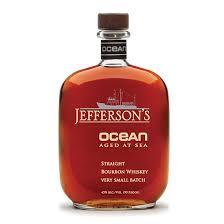Reviews of the Bartenura Moscato and the Jefferson’s Ocean, Aged at Sea, Kentucky Straight Bourbon Whiskey, Very Small Batch.
By Joshua E. London and Lou Marmon
Washington Jewish Week February 5, 2015

Moscato, a semi-sweet, lightly fizzy, typically simple wine, has become the darling of the hip-hop music scene over the last few years. Extraordinarily popular artists, including Drake, Lil’ Kim, Kanye West and the interestingly named “Waka Flocka Flame”, have sung about or have been seen consuming Moscato which has led to the wine booming in sales.
Moscato is made from Muscat grapes, most famously from the Piedmont region in northwest Italy, though Muscat is cultivated around the globe. One of the brands of Italian Moscato that has most benefited from this surge is kosher. Prior to the current popularity, one of the most dominant and recognizable Moscatos on the market happened to be the kosher Bartenura Moscato, a low-alcohol, Italian quaffer in a very distinctive blue bottle, imported by the Royal Wine Corp., the nationa’s largest producer, importer and distributer of kosher wines and grape juice (under its Kedem branch).
Back in the 1990s, Royal considered discontinuing the blue bottle. Now they sell several million bottles annually. Not only did the distinctive packaging place Bartenura in the right place at the right time, the Royal Wine marketing folks were savvy enough to recognize the opportunity and market it aggressively and intelligently. There is also, apperantly, an intrinsic appeal of kosher products because of their perceived “purity” which helps them gain traction in the marketplace.
The Bartenura Moscato ($15) is a semi-sweet, slightly fizzy, low-alcohol tropical fruit and citrus flavored wine. Not complex or ever meant to be anything but fun and light, it is a terrific aperitif, matching well with cheese and other simple fare as well as brunch and many desserts. In the summer it can be consumed like a soda, in a tumbler over ice. Enjoy!
Spirits-wise, we recently had an opportunity to sit down with Trey Zoeller, the President of Jefferson’s Bourbon, and taste with him an early sample of the delicious and soon to be released Jefferson’s The Manhattan Barrel Aged Cocktail. We’ll revisit this one in greater detail once it has been released. In the meantime, we thought a quick few words were in order regarding Jefferson’s Bourbon
Jefferson’s was started in 1997, by Trey Zoeller and his father Chet (who is also a well regarded bourbon historian). Jefferson’s is a non-distiller producer (NDP) of whiskey —meaning Zoeller sources his product on the open market and bottles it under his own label.
Unlike many other NDPs, however, Zoeller isn’t simply transferring other folk’s bourbon from one container to another and then marketing and selling it, he is, rather, blending and experimenting, taking risks, and really pushing the boundaries of bourbon. What he does takes real talent and hard work—hugely enjoyable work, to be sure, but hard work all the same. Most of the Jefferson’s portfolio is very competitively priced, with a few expensive, high-end offerings for us spare-no-expense whiskey geeks, and everything he produces is, so far, good –often really good – whiskey.
Here is a recent offering to consider:
Jefferson’s Ocean, Aged at Sea, Kentucky Straight Bourbon Whiskey, Very Small Batch (third batch; 45 percent abv; $85): A second follow-up to the original “Ocean” release, itself just an experiment to see what would happen to bourbon aged on the bow of a ship as it constantly swayed and rocked in the barrel, this third batch of already mature bourbon spent an additional 5 months in barrel at sea, stopping in at 5 different continents and crossing the equator 4 times. The result is wonderfully balanced bourbon with layered notes of heavy caramel and vanilla, with brown sugar, maple, syrup, sweet corn, raisons, cherries, cinnamon and some soft yet noticeable brine (though less than in the last batch). Very nice indeed. L’Chaim!
